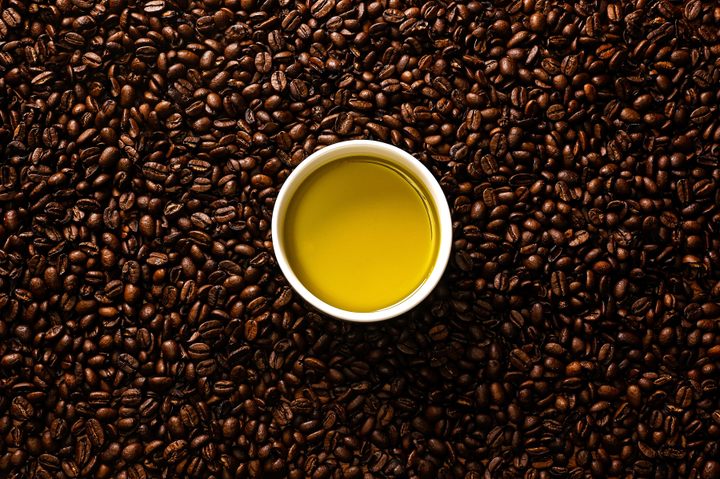

How Olive Oil and Coffee Came Together in a Cup
At first glance olives and coffee might seem to go together like, well, oil and water. But these Italian essentials possess deep cultural similarities—not to mention complementary flavors.
Sicily’s olive farmers wake up at dawn during the autumn harvest. As daylight breaks over the Mediterranean’s largest island, many of them begin their mornings by drinking a spoonful of the liquid gold, followed by coffee–a cup of espresso, perhaps, or a latte macchiato (warm milk with strong coffee, brewed using a traditional moka pot).
Long hours of picking and pressing await, a process that can occupy growers across Sicily–famed for being one of Italy’s largest producers of olive oil–from 6 a.m. onward for weeks on end. Beverage breaks throughout workdays, however, will provide the busy harvesters with opportunities to decompress. This is Italy, where, thanks to homegrown innovations like the espresso machine and the standing cafe, it’s par for the course to partake in a quick yet social caffè from sunup to sundown. Many Italians drink coffee all day long, starting in the morning and often ending evenings with it as a digestive.
Coffee is consumed by billions of people across the globe, a practice that can be traced back to Sufi mystics in 15th-century Arabia, according to British historian Jonathan Morris, author of Coffee: A Global History. The Coffea arabica shrub grows native in the southwestern Ethiopian highlands and in neighboring Kenya and South Sudan. Ethiopians boiled dried coffee cherry husks with water, and word of the resulting beverage traveled to Yemen, where Islamic authorities approved it as fuel for all-night prayer sessions. The drink eventually penetrated the social sphere; arabica beans were cultivated in Yemen and traded throughout the Middle East with the rise of the world’s first coffee houses. By the 1570s, coffee had arrived in Venice, courtesy of Turkish merchants–followed by greater Europe, and later the wider world.

In just a few short centuries, coffee lovers around the world have adapted it to their own lifestyles, preferences, and technologies: Swedes enjoy fika, the practice of gathering once or twice daily with friends, family, and colleagues for conversation over coffee and pastry. (Scandinavians prefer drip coffee that contains double the ratio of coffee to water than in the U.S., served in tiny cups.) Malaysians meet up with peers for kopi, a type of coffee brewed using a sock-like cloth filter that’s continuously dipped into hot water to create extra Joe when customers crave another round. And Italy is the much-vaunted birthplace of espresso, the cornerstone of one of the world’s most distinct coffee cultures. It began in the early 20th century with the development of machines that harnessed pressure to “expressly” make strong, single cups of coffee for individual patrons by forcing water through fine grounds. These devices found a place in the country’s new so-called “American” standing bars, where customers waited for their orders on foot and paid less as a result.
By the 1950s and 1960s, as espresso machines evolved to become increasingly efficient and sophisticated, more standing coffee shops popped up in cities as the nation’s population migrated in droves within the country. These public spaces provided an inexpensive and convenient space to take a breather throughout the day, and they became the template for the modern gulp-and-go Italian coffee bar.
Today, Italians largely drink coffee outside the home at coffee bars, although some will still make it in their own kitchens using a two-chamber stovetop moka pot or a capsule machine. And during warmer months, refreshing coffee-based treats like a shekerato freddo (a frothy espresso blend, shaken up and stirred with ice) or an espresso granita (a sweet, creamy blend of crushed ice and espresso) are a welcome treat for Sicilians.

Just as coffee is an essential part of Italian culture, so is olive oil. Its use in Italy dates back thousands of years. Today Sicilians rely on olive oil not just to prepare and flavor food but to moisturize their bodies, manufacture products like soap, polish furniture and lubricate machinery. Many Sicilians even swallow a tablespoon raw before their morning coffee as part of a personal ritual–a practice that captured the imagination of Starbucks founder, Howard Schultz, during a transformative trip abroad.
Coffee and olives: two tiny fruits with strong tastes and epic legacies in Italy. They seamlessly weave together throughout daily life there but had somehow never come together in a cup – until last year, while Schultz was traveling through Sicily. Taking a cue from locals, Schultz began consuming a tablespoon of olive oil each morning along with his morning coffee. A flash of inspiration surfaced: why not try the two together?

The unexpected alchemy of pairing coffee and extra virgin olive oil left Schultz “absolutely stunned,” he recalls. “In both hot and cold coffee beverages, what it produced was an unexpected, velvety, buttery flavor that enhanced the coffee and lingers beautifully on the palate.” Home awaited him, but so did the Starbucks beverage development team in Seattle, giving Schultz the chance to recreate his ah-hah moment on a larger scale.
Amy Dilger, principal product developer, R&D at Starbucks, knew they’d stumbled across a special synergy when Schultz shared news of his discovery.

The key word they came back to while creating Oleato™ beverages –a new line of Italian-inspired drinks, which recently debuted to the world at the Starbucks Reserve® Roastery in Milan–was alchemy. Instead of simply combining coffee and olive oil, why not transform the two ingredients into something new? “When you infuse Partanna® extra virgin olive oil by steaming or shaking it with oatmilk, it creates this luxurious, textural experience that’s similar to whole milk,” Dilger says.
That said, “the Oleato™ Cafe Lattè with Oatmilk has a creaminess to it,” Gastro Obscura’s Rachel Rummel clarifies. “I felt like the olive oil was a subtle secret ingredient; almost like a magic ingredient.” And when it came to the Oleato™ Iced Shaken Espresso with Oatmilk and Toffeenut, and the Oleato Golden Foam™ Cold Brew, the olive oil added a rich, almost caramel-like sweetness to the coffee’s overall flavor.

“I realized that each different way of infusing [olive oil into] the drink added something unique,” Rummel concluded–a twist on an age-old Sicilian tradition that creates a revelatory experience for coffee lovers around the world.
Beverages are now available in select Starbucks storefronts in Los Angeles and Seattle and coming to extended markets soon.
Click here to explore more.




















Follow us on Twitter to get the latest on the world's hidden wonders.
Like us on Facebook to get the latest on the world's hidden wonders.
Follow us on Twitter Like us on Facebook